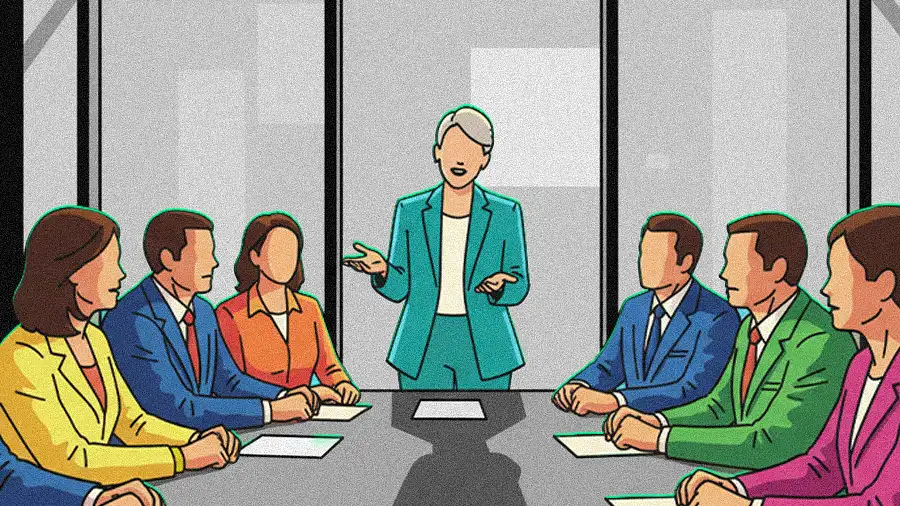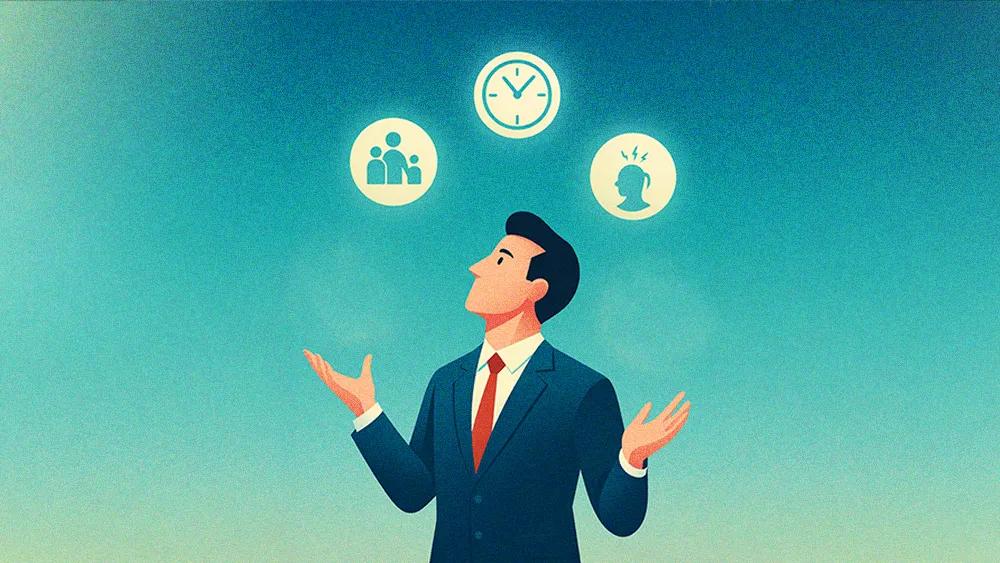Leaders Turn To A “Know Your Employee” Strategy To Build Stronger Companies

Key Points
Many companies fail at transformation because they focus on technology and overlook the people expected to make it work.
Joseph Boragina, Regional Vice President of Enterprise Sales at nCino, notes that real change begins when leaders “Know Their Employee” as well as their customer.
He explains that listening to employees turns resistance into insight, fueling innovation, stronger engagement, and better customer experiences.
Everybody talks about knowing your customer. KYC is so important. But knowing your employee can be just as important, too. You have to listen to the voice of the employee because, at the end of the day, they're an extension of the business. They are the brand. A consumer isn't thinking about the CEO; they're thinking about that first-line person they work with on a regular basis.

Joseph Boragina
Regional Vice President, Enterprise Sales
nCino
*All opinions expressed in this piece are those of Joseph Boragina, and do not necessarily reflect the views of any organization.
Every company studies its customers, but few apply that same curiosity to their own people. Real transformation begins with understanding what employees need, what fuels their resistance, and what makes them feel valued. When employees are treated as active shapers of the brand instead of passive executors, pushback turns into progress. It’s a shift from “Know Your Customer” to “Know Your Employee,” and it just might be the smartest move a company can make.
Joseph Boragina, Regional Vice President of Enterprise Sales at cloud banking leader nCino, has built his career where enterprise tech meets real-world banking. As a former Commercial Relationship Manager at BMO Financial Group, he learned that transformation is never about shiny tools but about people, and that big ideas fail when they forget the humans expected to bring them to life. For Boragina, real transformation begins with people, and a people-first strategy remains the most reliable path to ROI.
The first misstep in any transformation is focusing on technology as a silver bullet while neglecting the human element. Leadership teams may chase a “North Star” of autonomous systems, but they often fail to make that change digestible for the people on the ground. Without a clear communication strategy, Boragina explains, even the most promising tech fails to deliver, resulting in poor adoption and pushback.
Instead, the entire approach needs a rethink. For Boragina, a company’s external success is simply a mirror of its internal health. The path to a better customer experience begins with the employee experience. “Everybody talks about knowing your customer. KYC is so important. But knowing your employee can be just as important, too. You have to listen to the voice of the employee because, at the end of the day, they’re an extension of the business. They are the brand. A consumer isn’t thinking about the CEO; they’re thinking about that first-line person they work with on a regular basis,” says Boragina.
Friction as fuel: Adopting this mindset transforms pushback from a problem into a rich source of intelligence. “Pushback could be an employee who has found a better way of doing business. No matter how senior you are, you don’t have all the answers. That new perspective is something you have to consider,” Boragina explains. “It’s great to work smarter, not harder. So when an employee questions why a process is the way it is and suggests a more efficient alternative, that’s fantastic. That’s an opinion you need to hear.”
The status quo test: “In interviews, I always ask candidates what they would change about their current organization’s processes. It helps me understand if they just go along with the status quo or if they actually take the time to think about how things can be improved,” he continues.
The payoff for this internal work is felt directly by the customer. When employees understand the purpose behind a new system, they’re more likely to adopt it. In a financial services setting, Boragina explains, this can fundamentally change the experience. A new employee, armed with good data in a unified system, can move beyond repetitive questions and instead “give a fresh perspective to that customer and improve the customer experience.”
The why cascade: “You have to make sure that managers at every level are equipped with the right tools. When their teams have questions, they need to be able to have a deeper conversation about the purpose behind the change.”
From tedious to transformational: When people understand the purpose behind a change, even routine tasks start to feel different. As Boragina explains, “When everyone buys into the process, the act of inputting information is transformed from a tedious task into a meaningful business process where the purpose becomes much clearer.”
But for any of this to work, leadership must model the change they wish to see. By actively listening and proving that feedback can lead to real change, leaders create a culture of ownership and innovation. For Boragina, this isn’t just a philosophy he preaches; it’s a reality he has lived. He was once that employee who spoke up, and being heard, he says, was the ultimate motivator.
“I was invigorated because I knew that the organization actually listened. If there was a better way of doing business, they were willing to adopt something that wasn’t always there.” That experience shaped how he leads today, reinforcing his belief that innovation starts with listening. “My message is simple: speak up. If you see something that could be done in a better way, we want that friction. We know we’re not perfect, and we want thought leaders who can bring a different perspective,” Boragina concludes.
Pushback could be an employee who has found a better way of doing business. No matter how senior you are, you don't have all the answers. That new perspective is something you have to consider. It's great to work smarter, not harder. So when an employee questions why a process is the way it is and suggests a more efficient alternative, that's fantastic. That's an opinion you need to hear.

Joseph Boragina
Regional Vice President, Enterprise Sales
nCino
Pushback could be an employee who has found a better way of doing business. No matter how senior you are, you don't have all the answers. That new perspective is something you have to consider. It's great to work smarter, not harder. So when an employee questions why a process is the way it is and suggests a more efficient alternative, that's fantastic. That's an opinion you need to hear.

Joseph Boragina
Regional Vice President, Enterprise Sales
nCino
Related articles
TL;DR
Many companies fail at transformation because they focus on technology and overlook the people expected to make it work.
Joseph Boragina, Regional Vice President of Enterprise Sales at nCino, notes that real change begins when leaders “Know Their Employee” as well as their customer.
He explains that listening to employees turns resistance into insight, fueling innovation, stronger engagement, and better customer experiences.

Joseph Boragina
nCino
Regional Vice President, Enterprise Sales

Regional Vice President, Enterprise Sales
*All opinions expressed in this piece are those of Joseph Boragina, and do not necessarily reflect the views of any organization.
Every company studies its customers, but few apply that same curiosity to their own people. Real transformation begins with understanding what employees need, what fuels their resistance, and what makes them feel valued. When employees are treated as active shapers of the brand instead of passive executors, pushback turns into progress. It’s a shift from “Know Your Customer” to “Know Your Employee,” and it just might be the smartest move a company can make.
Joseph Boragina, Regional Vice President of Enterprise Sales at cloud banking leader nCino, has built his career where enterprise tech meets real-world banking. As a former Commercial Relationship Manager at BMO Financial Group, he learned that transformation is never about shiny tools but about people, and that big ideas fail when they forget the humans expected to bring them to life. For Boragina, real transformation begins with people, and a people-first strategy remains the most reliable path to ROI.
The first misstep in any transformation is focusing on technology as a silver bullet while neglecting the human element. Leadership teams may chase a “North Star” of autonomous systems, but they often fail to make that change digestible for the people on the ground. Without a clear communication strategy, Boragina explains, even the most promising tech fails to deliver, resulting in poor adoption and pushback.
Instead, the entire approach needs a rethink. For Boragina, a company’s external success is simply a mirror of its internal health. The path to a better customer experience begins with the employee experience. “Everybody talks about knowing your customer. KYC is so important. But knowing your employee can be just as important, too. You have to listen to the voice of the employee because, at the end of the day, they’re an extension of the business. They are the brand. A consumer isn’t thinking about the CEO; they’re thinking about that first-line person they work with on a regular basis,” says Boragina.
Friction as fuel: Adopting this mindset transforms pushback from a problem into a rich source of intelligence. “Pushback could be an employee who has found a better way of doing business. No matter how senior you are, you don’t have all the answers. That new perspective is something you have to consider,” Boragina explains. “It’s great to work smarter, not harder. So when an employee questions why a process is the way it is and suggests a more efficient alternative, that’s fantastic. That’s an opinion you need to hear.”
The status quo test: “In interviews, I always ask candidates what they would change about their current organization’s processes. It helps me understand if they just go along with the status quo or if they actually take the time to think about how things can be improved,” he continues.

Joseph Boragina
nCino
Regional Vice President, Enterprise Sales

Regional Vice President, Enterprise Sales
The payoff for this internal work is felt directly by the customer. When employees understand the purpose behind a new system, they’re more likely to adopt it. In a financial services setting, Boragina explains, this can fundamentally change the experience. A new employee, armed with good data in a unified system, can move beyond repetitive questions and instead “give a fresh perspective to that customer and improve the customer experience.”
The why cascade: “You have to make sure that managers at every level are equipped with the right tools. When their teams have questions, they need to be able to have a deeper conversation about the purpose behind the change.”
From tedious to transformational: When people understand the purpose behind a change, even routine tasks start to feel different. As Boragina explains, “When everyone buys into the process, the act of inputting information is transformed from a tedious task into a meaningful business process where the purpose becomes much clearer.”
But for any of this to work, leadership must model the change they wish to see. By actively listening and proving that feedback can lead to real change, leaders create a culture of ownership and innovation. For Boragina, this isn’t just a philosophy he preaches; it’s a reality he has lived. He was once that employee who spoke up, and being heard, he says, was the ultimate motivator.
“I was invigorated because I knew that the organization actually listened. If there was a better way of doing business, they were willing to adopt something that wasn’t always there.” That experience shaped how he leads today, reinforcing his belief that innovation starts with listening. “My message is simple: speak up. If you see something that could be done in a better way, we want that friction. We know we’re not perfect, and we want thought leaders who can bring a different perspective,” Boragina concludes.




